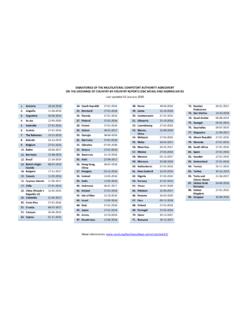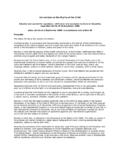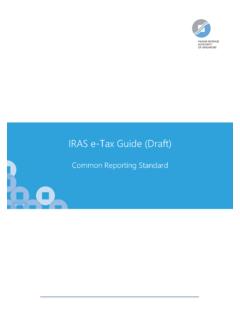Transcription of Action 13: Country-by-Country Reporting Implementation …
1 OECD/G20 Base Erosion and Profit Shifting ProjectAction 13: Country-by-Country ReportingImplementation Package OECD/G20 Base Erosion and Profit Shifting Project Action 13: Country-by-Country Reporting Implementation Package Photo credits: Cover archerix / OECD 2015 You can copy, download or print OECD content for your own use, and you can include excerpts from OECD publications, databases and multimedia products in your own documents, presentations, blogs, websites and teaching materials, provided that suitable acknowledgment of the source and copyright owner is given. All requests for public or commercial use and translation rights should be submitted to Requests for permission to photocopy portions of this material for public or commercial use shall be addressed directly to the Copyright Clearance Center (CCC) at or the Centre fran ais d'exploitation du droit de copie (CFC) at TABLE OF CONTENTS 3 Country-by-Country Reporting Implementation PACKAGE OECD 2015 Table of contents Introduction.
2 5 Model Legislation Related to Country-by-Country Reporting .. 9 Multilateral Competent Authority Agreement on the Exchange of Country-by-Country Reports .. 15 Annex to the Agreement Confidentiality and Data Safeguards Questionnaire .. 23 Annex I. Competent Authority Agreement on the Exchange of Country-by-Country Reports on the Basis of a Double Tax Convention ( DTC CAA ) .. 31 Annex II. Competent Authority Agreement on the Exchange of Country-by-Country Reports on the Basis of a Tax Information Exchange Agreement ( TIEA CAA ) .. 37 INTRODUCTION 5 Country-by-Country Reporting Implementation PACKAGE OECD 2015 Introduction 1. The Base Erosion and Profit Shifting (BEPS) Action Plan adopted by the OECD and G20 countries in 2013 recognised that enhancing transparency for tax administrations by providing them with adequate information to assess high-level transfer pricing and other BEPS-related risks is a crucial aspect for tackling the BEPS problem.
3 2. Against that background, the September 2014 Report on Action 13 (the September 2014 Report ) provides a template for Multinational Enterprises (MNEs) to report annually and for each tax jurisdiction in which they do business the information set out therein. This report is called the Country-by-Country (CbC) Report. 3. Following the adoption and publication of the September 2014 Report, further work has been undertaken with a view to defining (i) the timing of preparation and filing of the CbC Report, (ii) the scope of MNEs subject to CbC Reporting , (iii) the conditions underpinning the obtaining and use of the CbC Report, and (iv) the framework for government-to-government mechanisms to exchange CbC Reports, including the preferred exchange instrument in order to ensure that the CbC Report of an MNE Group can be made available in a timely and efficient manner to the tax authorities of jurisdictions in which the MNE Group has business activities and the secondary mechanism for the filing of CbC Reports, in case a jurisdiction fails to provide information to a jurisdiction meeting the conditions for receipt of such information because (a) it has not required CbC Reporting from the Ultimate Parent Entity of such MNE groups, (b) no competent authority agreement has been agreed in a timely manner under the current international agreements of the jurisdiction for the exchange of the CbC Reports or (c)
4 It has been established that there is a failure to exchange the information in practice with a jurisdiction after agreeing with that jurisdiction to do so. Jurisdictions are encouraged to expand the coverage of their international agreements for the exchange of information, which will be an integral part of the ongoing monitoring process. These aspects have been reflected in a guidance note on the Implementation of transfer pricing documentation and Country-by-Country Reporting in February 2015 (hereafter the February 2015 Guidance , available under ). It is recognised that developing countries may require support for the effective Implementation of CbC Reporting . 4. In accordance with the February 2015 Guidance, the Country-by-Country Reporting Implementation Package consists of (i) model legislation which could be used by countries to require the ultimate parent entity of an MNE group to file the CbC Report in its jurisdiction of residence including backup filing requirements and (ii) three model Competent Authority Agreements that could be used to facilitate Implementation of the exchange of CbC Reports, respectively based on the 1) Multilateral Convention on Administrative Assistance in Tax Matters, 2) bilateral tax conventions and 3) Tax Information Exchange Agreements (TIEAs).
5 6 INTRODUCTION Country-by-Country Reporting Implementation PACKAGE OECD 2015 Model legislation 5. The model legislation contained in the Country-by-Country Reporting Implementation Package takes into account neither the constitutional law and legal system, nor the structure and wording of the tax legislation of any particular jurisdiction. Jurisdictions will be able to adapt this model legislation to their own legal systems, where changes to current legislation are required. Competent Authority Agreements 6. The Convention on Mutual Administrative Assistance in Tax Matters (the Convention ), by virtue of its Article 6, requires the Competent Authorities of the Parties to the Convention to mutually agree on the scope of the automatic exchange of information and the procedure to be complied with. In the context of the Common Reporting Standard, this requirement has been translated into a Multilateral Competent Authority Agreement, which defines the scope, timing, procedures and safeguards according to which the automatic exchange should take place.
6 7. As the Implementation of the automatic exchange of information by means of a Multilateral Competent Authority Agreement in the context of the Common Reporting Standard has proven both time- and resource-efficient, the same approach could be used for the purpose of putting the automatic exchange of information in relation to CbC Reports in place. Therefore, the Multilateral Competent Authority Agreement on the Exchange of CbC Reports (the CbC MCAA ) has been developed, based on the Convention and inspired by the Multilateral Competent Authority Agreement concluded in the context of the Implementation of the Common Reporting Standard. In addition, two further model competent authority agreements have been developed for exchanges of CbC Reports, one for exchanges under Double Tax Conventions (Annex I) and one for exchanges under Tax Information Exchange Agreements (Annex II).
7 8. In line with paragraph 5 of the September 2014 Report, one of the three objectives of transfer pricing documentation is to provide tax administrations with the information necessary to conduct an informed transfer pricing risk assessment, while paragraph 10 states that effective risk identification and assessment constitute an essential early stage in the process of selecting appropriate cases for transfer pricing audit. The CbC Reports exchanged on the basis of the model competent authority agreements contained in the present Country-by-Country Reporting Implementation Package, represent one of the three tiers of the transfer pricing documentation and will, in accordance with paragraphs 16, 17 and 25 of the September 2014 Report, provide tax administrations with relevant and reliable information to perform an efficient and robust transfer pricing risk assessment analysis.
8 Against that background, the model competent authority agreements aim to provide the framework to make the information contained in the CbC Report available to concerned tax authorities, such information being foreseeably relevant for the administration and enforcement of their tax laws through the automatic exchange of information. 9. The purpose of the CbC MCAA is to set forth rules and procedures as may be necessary for Competent Authorities of jurisdictions implementing BEPS Action 13 to automatically exchange CbC Reports prepared by the Reporting Entity of an MNE Group and filed on an annual basis with the tax authorities of the jurisdiction of tax residence of that entity with the tax authorities of all jurisdictions in which the MNE Group operates. INTRODUCTION 7 Country-by-Country Reporting Implementation PACKAGE OECD 2015 10.
9 For most provisions, the wording is substantially the same as the text of the Multilateral Competent Authority Agreement for the purpose of exchanges under the Common Reporting Standard. Where appropriate, the wording has been complemented or amended to reflect the content of the September 2014 Report and the February 2015 Guidance. 11. As a next step, it is intended that an XML Schema and a related User Guide will be developed with a view to accommodating the electronic exchange of CbC Reports. INTRODUCTION 9 Country-by-Country Reporting Implementation PACKAGE OECD 2015 Model Legislation Related to Country-by-Country Reporting Article 1 Definitions For purposes of this [title of the law] the following terms have the following meanings: 1. The term Group means a collection of enterprises related through ownership or control such that it is either required to prepare Consolidated Financial Statements for financial Reporting purposes under applicable accounting principles or would be so required if equity interests in any of the enterprises were traded on a public securities exchange.
10 2. The term MNE Group means any Group that (i) includes two or more enterprises the tax residence for which is in different jurisdictions, or includes an enterprise that is resident for tax purposes in one jurisdiction and is subject to tax with respect to the business carried out through a permanent establishment in another jurisdiction, and (ii) is not an Excluded MNE Group. 3. The term Excluded MNE Group means, with respect to any Fiscal Year of the Group, a Group having total consolidated group revenue of less than [750 million Euro] / [insert an amount in local currency approximately equivalent to 750 million Euro as of January 2015] during the Fiscal Year immediately preceding the Reporting Fiscal Year as reflected in its Consolidated Financial Statements for such preceding Fiscal Year. 4. The term Constituent Entity means (i) any separate business unit of an MNE Group that is included in the Consolidated Financial Statements of the MNE Group for financial Reporting purposes, or would be so included if equity interests in such business unit of an MNE Group were traded on a public securities exchange; (ii) any such business unit that is excluded from the MNE Group s Consolidated Financial Statements solely on size or materiality grounds; and (iii) any permanent establishment of any separate business unit of the MNE Group included in (i) or (ii) above provided the business unit prepares a separate financial statement for such permanent establishment for financial Reporting , regulatory, tax Reporting , or internal management control purposes.












